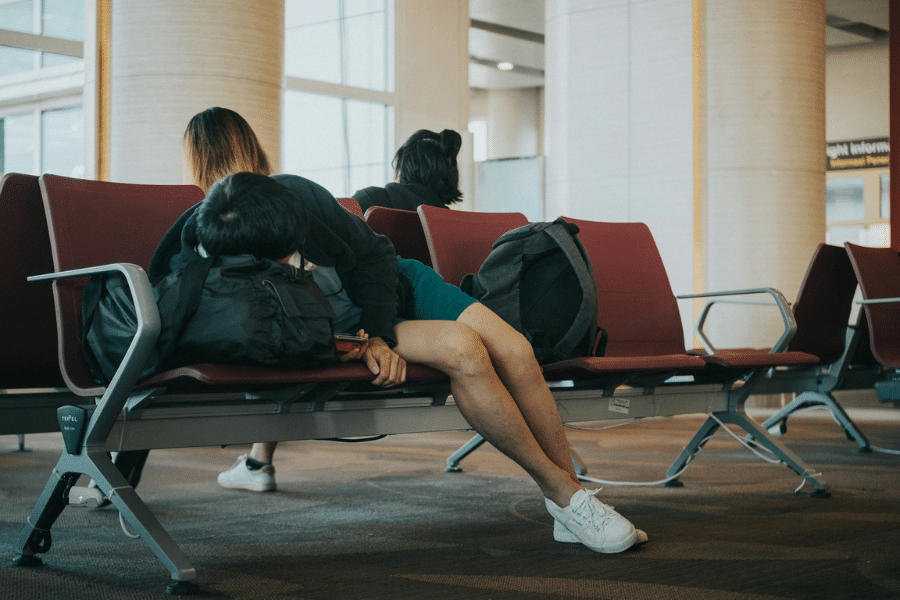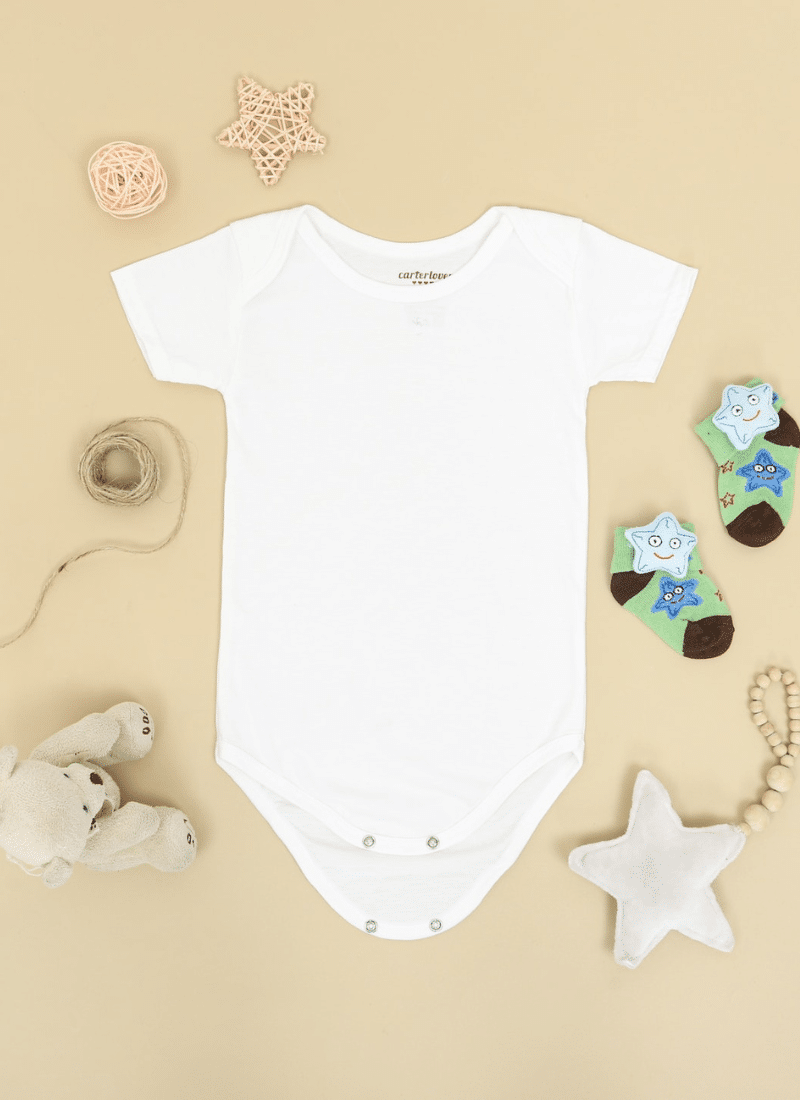This post will give you the best tips on how to manage jet lag with your baby!

Traveling with a baby can be very stressful. You'll most likely have a lot on your mind: what to pack ? what to bring on the plane? how is the baby going to do during the flight?
Especially if you are traveling long distance, jet lag can be an issue for your baby. Their whole schedule will change for a short period of time, before being changed again when you'll go back home.
To help you best manage during your next trip, we've prepared the top tips to manage jet lag with a baby.
Are you ready for your next trip ?
How long are babies in newborn diapers
Managing Jet Lag with a Baby: Tips for Travelers and Traveling Families
Managing jet lag with a baby can be challenging, but with the right strategies, it is possible to minimize its impact. Here are some tips for travelers and traveling families:
- Plan your flights strategically, choosing ones that align with your baby's sleep schedule.
- Gradually adjust your baby's sleep schedule before the trip to help them adapt to the new time zone.
- During the flight, keep your baby comfortable by bringing familiar items like blankets and toys.
- Implement feeding and napping strategies to help your baby adjust to the new schedule.
- Upon arrival, help your baby adapt to the new time zone by exposing them to natural light and keeping them active during the day.
- Establish a routine at the destination to provide a sense of familiarity and stability for your baby.
By following these tips and being flexible and patient, you can help your baby manage jet lag and enjoy your travels.
Understanding Jet Lag in Babies
Understanding jet lag in babies is important for parents who are planning to travel with their little ones. Jet lag occurs when there is a disruption in the body's internal clock, also known as the circadian rhythm, due to crossing multiple time zones. This can cause temporary sleep disturbances and other symptoms in both adults and babies.
Babies are particularly susceptible to jet lag because their sleep patterns are still developing. They may experience difficulty falling asleep or staying asleep, irritability, and changes in appetite and bowel movements. It's important for parents to be aware of these symptoms and take steps to help their babies adjust to the new time zone.
One way to minimize the impact of jet lag in babies is to gradually adjust their sleep schedule before the trip. This can be done by shifting their bedtime and nap times by a few minutes each day leading up to the travel date. Exposure to natural light during the day and keeping a consistent sleep environment can also help regulate their circadian rhythm.
During the flight, parents can make their baby's journey more comfortable by bringing familiar items such as a favorite blanket or toy. Creating a soothing and familiar sleep environment can help promote better sleep during the flight.
Upon arrival at the destination, parents should try to expose their baby to natural light and keep them active during the day to help reset their internal clock. Establishing a consistent routine for meals and sleep can also aid in the adjustment process.
By understanding the effects of jet lag in babies and implementing strategies to minimize its impact, parents can help their little ones adjust to the new time zone and enjoy a smoother travel experience.
Causes and Symptoms of Jet Lag in Babies
Understanding the causes and symptoms of jet lag in babies is essential for parents who are planning to travel with their little ones. Jet lag occurs when there is a disruption in the body's internal clock, also known as the circadian rhythm, due to crossing multiple time zones. This disruption can affect a baby's sleep patterns and overall well-being.
The main cause of jet lag in babies is the rapid change in time zones, which can confuse their internal clock and disrupt their sleep-wake cycle. This can result in difficulty falling asleep or staying asleep, irritability, changes in appetite, and digestive issues.
Some common symptoms of jet lag in babies include excessive sleepiness or difficulty sleeping, fussiness, poor feeding, and general discomfort. Babies may also experience changes in bowel movements and may have difficulty adjusting to the new schedule.
To help alleviate the symptoms of jet lag in babies, parents can take several steps. Gradually adjusting the baby's sleep schedule before the trip can help them adapt to the new time zone more easily. Providing a calm and familiar sleep environment during the flight can also promote better rest. Upon arrival at the destination, exposing the baby to natural light during the day and establishing a consistent routine for meals and sleep can help regulate their internal clock.
It's important for parents to be patient and understanding during this adjustment period and to provide comfort and reassurance to their babies. By recognizing the causes and symptoms of jet lag in babies and implementing appropriate strategies, parents can help their little ones navigate the challenges of traveling across time zones and ensure a smoother transition to the new environment.
Preparing for Travel with a Baby
Preparing for travel with a baby requires careful planning and organization. Here are some important steps to take:
- Make a checklist of essential items to pack, including diapers, baby clothes, feeding supplies, and medications.
- Check the airline's policies regarding baby equipment and seating arrangements.
- Ensure that your baby's travel documents, such as passports or identification cards, are up to date.
- Pack a carry-on bag with baby essentials, including snacks, toys, and a change of clothes.
- Research child-friendly accommodations and amenities at your destination.
- Arrange for transportation options that can accommodate a baby, such as car seats or strollers.
- Consult with your pediatrician about any necessary vaccinations or health precautions for your baby.
By taking these steps, you can ensure a smoother and more enjoyable travel experience for both you and your baby.
Choosing the Right Flight Schedule
Choosing the right flight schedule is crucial when traveling with a baby. Here are some factors to consider:
- Time of the flight: Opt for flights that align with your baby's sleep schedule. A red-eye or overnight flight may be ideal if your baby tends to sleep well during the night.
- Duration of the layovers: If you have layovers, consider the length of the layovers and whether it allows enough time for feeding, diaper changes, and rest.
- Direct vs. connecting flights: Direct flights are generally preferred to minimize disruptions and reduce travel time. However, if a connecting flight is necessary, choose one with a longer layover to allow for a more relaxed transfer.
- Seat selection: Consider choosing seats that provide extra legroom, bulkhead seats with bassinet attachments, or seats near the aisle for easier access during feeding and diaper changes.
- Flight timing and destination: If possible, choose a destination with a minimal time difference to minimize the impact of jet lag on your baby.
It's important to be flexible and realistic when planning the flight schedule. Keep in mind that unexpected delays or disruptions may occur, so be prepared for changes and have contingency plans in place. Additionally, consult with your pediatrician for any specific recommendations or precautions for air travel with your baby.
By carefully considering these factors and selecting a flight schedule that suits your baby's needs, you can make the journey more comfortable and enjoyable for both you and your little one.
Adjusting Baby's Sleep Schedule Before Travel
Adjusting your baby's sleep schedule before travel can help them adapt to the new time zone more easily. Here are some tips to consider:
- Start gradually: Begin shifting your baby's sleep schedule a few days or even a week before your trip. Move bedtime and nap times by 15-30 minutes each day to slowly transition them to the new schedule.
- Expose to natural light: During the day, expose your baby to natural light as much as possible. This helps regulate their internal clock and signals that it's daytime.
- Create a sleep-friendly environment: Establish a consistent and soothing bedtime routine that signals to your baby that it's time to sleep. Dim the lights, play calming music, and ensure the room is quiet and comfortable.
- Avoid stimulating activities before bedtime: Minimize screen time and engaging activities that can keep your baby alert and awake. Instead, opt for quiet play or reading books to help them wind down.
- Keep a consistent sleep environment: If possible, bring familiar items from home, such as a favorite blanket or stuffed animal, to create a sense of familiarity and comfort in the new environment.
Remember, every baby is different, and it may take some time for them to adjust. Be patient and understanding during this transition period. Once you arrive at your destination, continue to follow a consistent sleep routine to help your baby adapt to the new time zone.
By gradually adjusting your baby's sleep schedule and providing a sleep-friendly environment, you can help them transition smoothly and minimize the effects of jet lag on their sleep patterns.
During the Flight
During the flight, there are several things you can do to keep your baby comfortable:
- Bring essential items such as diapers, wipes, and a change of clothes in your carry-on bag.
- Use a baby carrier or sling to keep your hands free while moving around the cabin.
- Feed your baby during takeoff and landing to help relieve ear pressure.
- Bring familiar items like a favorite blanket or toy to provide comfort.
- Walk up and down the aisle with your baby to stretch their legs and keep them entertained.
Remember to follow the airline's guidelines for traveling with a baby and be considerate of other passengers. By being prepared and attentive to your baby's needs, you can make the flight more enjoyable for both of you.
Keeping Baby Comfortable on the Plane
Keeping your baby comfortable on the plane is essential for a smooth and enjoyable journey. Here are some tips to help:
- Dress your baby in comfortable and breathable clothing. Layering is recommended, as the temperature on the plane can fluctuate.
- Bring a soft blanket or swaddle to keep your baby cozy and provide a sense of familiarity.
- Use a travel pillow or a nursing pillow to support your baby's head and neck during sleep.
- Opt for a window seat, which can provide a more secure and private space for you and your baby.
- Consider using noise-canceling headphones or earplugs to block out any loud noises that may disturb your baby's sleep.
- Bring a variety of toys and activities to keep your baby entertained throughout the flight.
- Keep your baby well-hydrated by offering frequent feedings or sips of water, especially during takeoff and landing.
Additionally, don't hesitate to ask the flight attendants for assistance or any special accommodations you may need for your baby.
By implementing these tips and ensuring your baby's comfort, you can make the plane journey more pleasant for both of you.
Feeding and Napping Strategies
Having effective feeding and napping strategies can greatly contribute to your baby's comfort during the flight. Here are some strategies to consider:
- Feeding: If you are breastfeeding, try to nurse your baby during takeoff and landing to help alleviate ear pressure. If you are bottle-feeding, prepare the bottles in advance and bring extra formula or breast milk in case of delays.
- Napping: Encourage your baby to sleep during the flight by creating a calm and soothing environment. Bring a travel-friendly blanket or swaddle to provide a sense of security. Use a travel pillow or your arms to support your baby's head during naptime.
- Timing: Try to align feeding and napping schedules with the local time at your destination to help your baby adjust to the new time zone.
- Comfortable seating: If possible, choose a seat with extra legroom or book a bassinet attachment seat to provide a comfortable sleeping space for your baby.
- White noise: Use a white noise machine or a smartphone app to create a consistent and soothing background noise that can help your baby relax and fall asleep.
It's important to be flexible and adapt to your baby's needs during the flight. Don't worry if your baby's feeding and napping patterns are slightly disrupted. Once you arrive at your destination, establish a routine to help your baby readjust to the local time.
By implementing these feeding and napping strategies, you can help your baby stay comfortable and well-rested during the flight.
Arriving at the Destination
Arriving at the destination with your baby marks the end of the flight and the start of your new adventure. Here are some tips to make the transition smoother:
- Take your time to settle in and allow your baby to adjust to the new surroundings.
- Offer your baby plenty of fluids and snacks to keep them hydrated and energized.
- Expose your baby to natural light and outdoor activities to help regulate their internal clock.
- Stick to a consistent sleep and mealtime routine to provide a sense of familiarity and stability.
- Be patient and understanding as your baby adapts to the new time zone and surroundings.
By following these tips, you can help your baby ease into the new environment and enjoy your time at the destination.
Helping Baby Adapt to the New Time Zone
Helping your baby adapt to the new time zone is essential for a smoother transition during your travels. Here are some strategies to assist in their adjustment:
- Expose your baby to natural light during the day. This helps regulate their internal clock and signals that it's daytime.
- Engage in active play and stimulating activities during the day to keep your baby awake and alert.
- Establish a consistent sleep routine at the destination. Follow the local time for naps and bedtime to help your baby's body adjust to the new schedule.
- Create a sleep-friendly environment by keeping the room dark, quiet, and at a comfortable temperature.
- Use white noise or a gentle lullaby to help soothe your baby to sleep in the new environment.
- Be patient and flexible if your baby experiences some disruptions in sleep. It may take a few days for them to fully adapt.
- Offer comforting activities, such as cuddling or reading a favorite book, to help your baby relax and feel secure in the new surroundings.
Remember that every baby is different, and their adjustment to a new time zone may vary. By implementing these strategies and providing a consistent and comforting routine, you can help your baby adapt more smoothly to the new time zone and enjoy your travels.
Establishing a Routine at the Destination
Establishing a routine at the destination is crucial for helping your baby adjust to the new environment and time zone. Here are some tips to help you establish a routine:
- Stick to a consistent schedule for meals and naps. This helps regulate your baby's body clock and provides a sense of stability.
- Create a sleep-friendly environment by ensuring the room is dark, quiet, and at a comfortable temperature.
- Use familiar sleep cues, such as a favorite blanket or a soothing lullaby, to help your baby feel secure and relaxed during bedtime.
- Engage in calming activities before bedtime, such as reading a book or taking a warm bath, to help your baby wind down and prepare for sleep.
- Expose your baby to natural light during the day. This helps reinforce the new time zone and signals that it's daytime.
- Encourage regular physical activity and playtime during the day to help your baby expend energy and adjust to the new routine.
- Be patient and flexible as your baby adapts to the new routine. It may take a few days for them to fully adjust and settle into the new schedule.
By establishing a routine at the destination, you provide a sense of familiarity and consistency for your baby, which can help them feel more secure and adapt to the new time zone more smoothly.
Additional Tips for Managing Jet Lag with a Baby
Here are some additional tips for managing jet lag with a baby:
- Keep your baby well-hydrated by offering frequent feedings or sips of water.
- Ensure your baby gets plenty of rest and naps during the day to prevent overtiredness.
- Be flexible with your plans and allow for downtime to help your baby adjust to the new time zone.
- Expose your baby to natural light during the day and create a dark and quiet sleep environment at night.
- Use soothing techniques such as gentle massages or lullabies to help your baby relax and fall asleep.
By following these additional tips, you can help your baby navigate jet lag more effectively and enjoy your travels together.
Staying Hydrated and Well-Rested
Staying hydrated and well-rested is crucial for managing jet lag with a baby. Here are some tips to ensure your baby stays hydrated and gets enough rest:
- Offer frequent feedings or sips of water to keep your baby hydrated during the flight and throughout your travels.
- Pay attention to signs of hunger or thirst and respond promptly to your baby's needs.
- Create a sleep-friendly environment by keeping the room dark, quiet, and at a comfortable temperature. Use blackout curtains or a sleep mask if necessary.
- Establish a consistent bedtime routine to signal to your baby that it's time to sleep. This can include activities like a warm bath, reading a book, or listening to calming music.
- Encourage naps during the day to prevent overtiredness. Create a quiet and soothing environment for naps, such as using a white noise machine or providing a cozy sleep space.
- Be flexible with your schedule and allow for adequate rest periods throughout the day. Avoid overstimulation and prioritize your baby's sleep needs.
Remember to adjust your baby's sleep and feeding schedule gradually to align with the new time zone. By staying hydrated and well-rested, your baby will be better equipped to handle the effects of jet lag and enjoy a smoother transition.
Being Flexible and Patient
Being flexible and patient is key when managing jet lag with a baby. Here are some tips to help you navigate the challenges:
- Adjust your expectations and be prepared for disruptions in your baby's sleep and feeding routines. Jet lag can take a few days to resolve.
- Allow for extra time and be patient with your baby's needs. They may require more attention and comfort during this adjustment period.
- Be flexible with your plans and be open to adapting your schedule to accommodate your baby's sleep and feeding needs.
- Take advantage of quiet and calm moments to rest and recharge yourself. Self-care is important to stay patient and attentive to your baby's needs.
- Keep a positive mindset and embrace the journey. Traveling with a baby can be challenging, but it can also be a rewarding and enriching experience.
- Seek support from your travel companions or fellow parents who have gone through similar experiences. Sharing tips and experiences can be helpful and reassuring.
Remember that every baby is different, and it may take time for them to adjust to the new time zone. By being flexible and patient, you can create a more relaxed and enjoyable travel experience for both you and your baby.
This post has been the answer to the question: how long are babies in newborn diapers?
Save for Later on Pinterest !





Leave a Reply